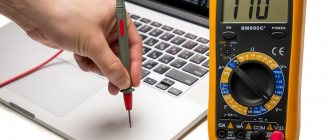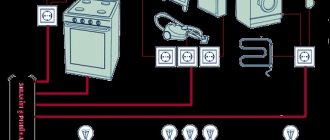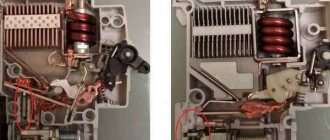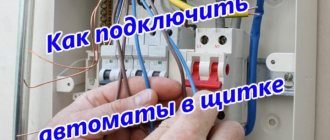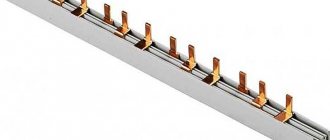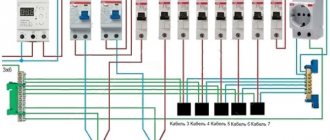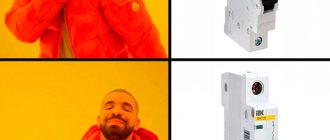Now are the times when the value of human life has become the main priority, and at the same time there are excesses - many restrictions and innovations are justified by safety. Today we will talk again about electrical safety, which is provided by a home electrical panel, through the prism of knowledge about short circuit current. Yes, this is not the first time I have raised this topic. But don’t rush to close the website! The topic concerns everyone - after all, it is a security topic! Spoiler: I will prove that panels equipped with machines with characteristic “B” are much more preferable for our houses and apartments.
In recent years, some restrictions and innovations have been introduced in the electrical engineering field, which serve primarily two purposes - preserving human life and preserving the life of equipment (from general to specific - electrical networks, electrical installations, loads). Fortunately, modern technologies and devices make it possible to ensure the safety of both people and wires.
Here is a partial list of the protections in our electrical panels that I am talking about:
- Automatic switches (AB), which turn off the power during overloads and short circuits. This is the only device in our electrical panels, the installation of which is strictly required in any case.
- Residual current devices (RCDs), or in the new-fashioned way, residual current switches (RCCBs), which turn off the power when a dangerous value of differential current appears (its appearance means that a dangerous and even fatal potential for humans may arise on the housings of the devices). This also includes RCBOs (automatic residual current switches), which are hybrids of AV and RCCBs.
- Voltage relays that turn off the power and thus protect equipment from overvoltage and undervoltage;
- Arc flash protection devices (AFDs) or anti-sparking devices (AFDs), which turn off the power if any kind of spark is suspected, even at low current.
- Surge protection devices (SPDs) or surge limiters (OSLs), which stop, to the best of their ability, powerful short-term voltage surges that can be caused by natural or man-made causes. Depending on the circuit configuration, the power in this case is also usually turned off.
On the one hand, people have become richer, and now many can afford electronic “things” that previously could only be dreamed of. On the other hand, these “things” have become more accessible in price and availability.
Some people say that this is “swindling the client out of money,” but I don’t agree with that. If the client values his life, is ready to pay for it, and understands what it is and why, then all possible protections must be put in place.
It is important that the installation of any protection must be justified, and its characteristics must be carefully calculated. After all, no protection, even the most necessary one, should be unnecessarily complex and ruin your nerves due to false positives.
Among illiterate electricians there is such a criterion for choosing a machine - “So as not to knock it out.”
In the article we will talk about how to most effectively protect electrical appliances and electrical wiring from short circuits (short circuits). This is done thanks to an innovation that enters our lives with great difficulty, despite the penny costs. The reason for this is the inertia of the Russian mentality, its ignorance and fears. Which I will dispel in this article.
For completeness, I recommend that you read my previous articles on this topic - “Short-circuit current: size matters” and “Selectivity in a home panel: how to achieve the impossible.”
First, as usual, a little background information.
What protection do we have and what protection do we lack?
In recent years, some restrictions and innovations have been introduced in the electrical engineering field, which serve primarily two purposes - preserving human life and preserving the life of equipment (from general to specific - electrical networks, electrical installations, loads). Fortunately, modern technologies and devices make it possible to ensure the safety of both people and wires.
Here is a partial list of the protections in our electrical panels that I am talking about:
- automatic switches (AB), which turn off the power during overloads and short circuits. This is the only device in our electrical panels, the installation of which is strictly required in any case. We will pay close attention to this in this article;
- residual current devices (RCDs), or, in a new-fashioned way, residual current switches (RCCBs), which turn off the power when a dangerous value of differential current appears (its appearance means that a dangerous and even fatal potential for humans may arise on the housings of the devices). This also includes RCBOs (automatic residual current switches), which are hybrids of AV and RCCB;
- voltage relays that turn off the power and thus protect equipment from overvoltage and undervoltage (and more);
- arc flash protection devices (AFDs) or spark protection devices (ASPDs), which turn off the power if sparking of any kind is suspected, even at low current;
- Surge protection devices (SPDs) or surge limiters (OSLs), which, to the best of our ability, stop powerful short-term voltage surges that can be caused by natural or man-made causes. Depending on the circuit configuration, the power in this case is also usually turned off.
On the one hand, people have become richer, and now many can afford electronic things that they could only dream of before. On the other hand, these “things” have become more accessible in price and availability.
Some say that this is “swindling the client out of money,” but I don’t agree with that. If the client values his life, is ready to pay for it, and understands what it is and why, then all possible protections and reserves must be put in place.
It is important that the installation of any protection must be justified, and its characteristics must be carefully calculated. After all, no protection, even the most necessary one, should be unnecessarily complex and ruin your nerves due to false positives.
Among illiterate electricians there is such a criterion for choosing a machine - “So as not to knock it out.”
In the article we will talk about how to most effectively protect electrical appliances and electrical wiring from short circuits (short circuits). This is done thanks to an innovation that enters our lives with great difficulty, despite the penny costs. The reason for this is the inertia of the Russian mentality, its ignorance and fears. Which I will dispel in this article.
For completeness, I recommend that you read my previous articles on this topic - Short-circuit current: size matters and Selectivity in a home panel: how to achieve the impossible.
First, as usual, a little background information.
Scope of application
- For stable operation of all devices, it is recommended to use voltage stabilizers.
- The optimal RCD leakage current should be 30 mA. If it is more, then the protection will be unsatisfactory. If it is less, there will be false alarms caused by the high sensitivity of the sensor.
- For household use, it is recommended to use machines marked C. For a socket network, it is advisable to use a C16 machine.
- The optimal class of RCD is A. Devices of the AC group may not always operate correctly.
- It’s better not to skimp on protection. Buy only high-quality devices from reputable manufacturers. Remember that the cost of the most expensive washing machine will be much lower than the price of a new washing machine.
Useful tips Connection diagrams Principles of operation of devices Main concepts Meters from Energomer Precautions Incandescent lamps Video instructions for the master Testing with a multimeter
Take care of the cable, Sanya!
On the issue of restrictions, it is worth mentioning that the requirements for the thermal conditions of cables have become more stringent. Although I don’t remember changes in regulatory and technical documentation (NTD) that could have caused this to happen. But I perfectly remember the surprised and indignant eyes of the “senior” electrician Ivanovich at one of my first objects, when he told me: “What 16? All my life the sockets were set to 25 Amps! Don’t be smart!” And now putting 16 A on socket lines with a copper cross-section of 2.5 mm² is the norm.
I think this happened for two reasons:
- Previously, one 25 A circuit breaker could power half an apartment, which meant several sockets, plus several incandescent light bulbs. This was due to poverty - this way you can save on both wires and automatic machines, of which there were usually 2 or 3 per apartment. In this case, the current on the line was relatively large, and with a rating of 16 A there would be relatively frequent shutdowns due to overload. Therefore, such a compromise was found. Now on one 16 A machine there are usually a maximum of 3 sockets, and the lighting is connected separately.
- More attention has been paid to the survivability and reliability of the cable. The main thing that determines the service life of a cable is its operating temperature. More precisely, the boundaries of temperature differences and the frequency of these changes. The more often and the greater the changes (the more often and the more the core heats up), the faster the insulation dries and loses resistance, and the faster the contacts at the joints deteriorate. The main factor influencing the heating of the core is current. Hence the logical conclusion - by limiting the current, we limit possible heating and increase the service life of the cable. In this sense, it turns out that to protect a cable with a cross-section of 2.5 mm2, a machine with a rating of 16 A has priority over 20 A, and even more so 25 A.
The permissible heating temperature of the cable cores for most cables is 70 °C. For more details, see GOST 31996-2012. The cross-sections and resistances of current-carrying conductors are described in GOST 22483-2012.
In addition, the new standards (SP 256.1325800.2016, amendment 3 of 2019, table 15.3) say that the cable of the socket group cannot have a cross-section of less than 2.5 mm2. That is, now there is no way to save on cable, even if a 200 W refrigerator “hangs” on this line, and the rating of the machine is 6 A. If the line to the sockets is laid with a cable with aluminum conductors, its cross-section must be at least 4 mm2.
2.5 squares, SP table. You can’t do less, even if you install a 6 A machine
If you dig further into the topic, you can find slightly different information in the PUE (Table 7.1.1):
PUE table 7.1.1 – 1.5 mm2 possible
Contradiction? No. If two rules diverge, the newer and stricter one should be used. And the new rules, as a rule, are stricter than the old ones.
Aluminum cable is changing its properties and may soon officially appear in our homes. Read about this in my article about new aluminum.
Using cable as an example, we can say that the operating modes of many electrical network components have become more gentle, and the components themselves are better protected.
Unit conversion rules
To determine electrical power through the network current indicator, you can use various tools with which measurements and calculations are made:
Using a tester, we measure the voltage in the electrical network we are interested in, and then use a current clamp to determine the current strength. Having obtained the necessary indicators and applying the existing formula for calculating direct and alternating current, you can calculate the power. We divide the existing result in watts by 1000 and get the number of kilowatts.
Single phase electrical circuit
Basically, all household electrical networks are single-phase networks that use a voltage of 220 volts. The load marking for them is written in kilowatts, and the current strength is in amperes and is designated as AB.
To convert one unit to another, the formula of Ohm's law is used, which states that power ( P ) is equal to current ( I) multiplied by voltage ( U ). That is, the calculation will look like this:
In practice, such a calculation can be applied, for example, to the designations on old electricity meters, where the installed machine is designed for 12 A. Substituting digital values into the existing formula, we get:
In cases where the network load is mixed, the value of this parameter fluctuates around 0.85. Reducing the reactive component of power leads to a reduction in losses in the network, which increases the power factor. Many manufacturers, when marking a device, indicate this parameter on the label.
Three-phase electrical network
If we take the example of a three-phase network, then everything is somewhat different here, since three phases are involved. When making calculations, you need to take the value of the electric current of one of the phases, which is multiplied by the voltage in this phase, after which the resulting result is multiplied by cos φ, that is, by the phase shift.
Having thus counted the voltage in each phase, we add up the results and obtain the total power of the device, which is connected to a three-phase network. In formulas it looks like this:
Watt = √3 Ampere x Volt or P = √3 x U x I
It must be borne in mind that there is a difference between phase and line voltage and current. But the calculation formula remains the same, except for the case when the connection is made in the form of a triangle, and it is necessary to calculate the load of an individual connection.
For circuits with alternating current, there is an unspoken rule for this calculation: the current strength is divided in half to select the power of the protective and starting relays. The same rule applies when calculating the diameter of the conductor in such electrical circuits.
Short circuit protection
The most important point in this matter is that with such a formidable phenomenon as a short circuit, the eyes of all inhabitants of the home are hopefully turned to the electromagnetic release, which is an integral part of every modern circuit breaker. It is he who saves all participants in the electrical circuit - from the short circuit to the AB terminals.
What guarantees can the machine provide us in the event of a short circuit? To answer this question, it is fundamentally important to know the ratio of the short-circuit current and the “nominal” of the electromagnetic (EM) release (current multiplicity). The main and only condition for turning off the circuit in such incidents is that the operating current of the EM release in any case must be less than the expected short-circuit current.
Otherwise, the thermal release will have to take over, but it works reluctantly, lazily - unlike its electromagnetic partner. As a result, in a few agonizing seconds, until the thermal release gives the command to open, something irreparable can happen. For example, the twist of aluminum and copper that a young Tajik tiler made when he moved a socket in the bathroom will burn out.
I witnessed the incident. He was near the shield in a house in the private sector. Suddenly I saw that the insulation on the wire coming from the C25 machine began to “float” right before my eyes. At this time, at the other end of the house - in the kitchen - a furniture installer was working. The guy with the screwdriver, without knowing it, caused a short circuit by driving a self-tapping screw into the cable. The machine would not have turned off without my help - the short-circuit current was too low in that place.
Knowing the expected short-circuit current and the release characteristic (in the case of a home panel it is “B” or “C”), we can say for sure whether the machine will be able to save the situation in the event of a short circuit (we talked about this in other articles). But in most cases we know the short-circuit current only approximately - after all, it can change unpredictably due to many factors. What to do?
My answer is this. We play it safe with the cable by lowering the expected current (limiting it) using the rated current AB. But it is not always possible to lower the rating of the machine - it “rests” on the rated current consumed by the load. This means that you need to lower the “rating” of the EM release. But this must be done wisely - so as to ensure circuit breakage at extremely low short-circuit currents, while at the same time not limiting the load in any way. Logical reinsurance?
In other words, you need to “lower the letter” of the electromagnetic release from “C” to “B” in order to get more guarantees of shutdown during a short circuit. How to do this, ensuring maximum protection, and at the same time eliminating false positives? The answer will be in this article.
Why change the machine?
Any electrician will say: “If there is no urgent need, it is better not to get into the electrical wiring of the house with your own hands.” The consequences can be dire. When does such a need arise?
In order to change the socket, you need to know physics in grades 8-9. With other electrical components, everything is a little more complicated. If a circuit breaker in your apartment regularly trips (the circuit breaker in the panel) and the light goes out, it’s time to change it.
Probably, the circuit breaker has exhausted its service life, even though the period specified in the passport has not yet expired. A worn-out 16 A device may operate at low load on the network (10 A), or may not operate at extreme values (contacts will solder together, and then there will be a fire).
Just in case, let us recall some information from the school curriculum:
- Power = Voltage x Current.
- Current = Power Voltage.
The voltage in the socket is 220 V. The coffee maker indicates 1200 W, which means the current consumption will be 1200220 = 5.45 (A).
If you managed to add up the power of all household electrical appliances and calculate the total current, you can consider yourself a second-level electrician.
What is the relationship between the characteristics of the machine and the short-circuit current?
I have written about this several times. The chronology can be restored as follows:
- First, I talked about the characteristics of circuit breakers and how they are better than fuses.
- Then, for convenience, I compiled tables of the operation of AVs of different ratings at different currents, including during overloads and short circuits. It's strange that no one has done this before. Apparently, I’m very lazy - I didn’t want to run the calculator every time or count the currents in my head.
- Then I wondered what short-circuit current is, and, having been frightened by the consequences of a short-circuit at work, I decided to measure it in my apartment and at the dacha.
- Seeing that the current was too low, I changed the circuit breakers in the apartment panel.
- And recently I published an article in which I discuss whether it is possible to achieve selectivity between machines in everyday conditions. Spoiler: it is possible, but difficult.
Device cost
Switch c25 ABB
The price of a three-phase packager ranges from 64 to 2000 rubles. The cost depends on technical characteristics, throughput, quality and brand.
Switch s25 KEAZ
The 380 volt 25 ampere machine will be useful for users who experience frequent power outages, network overload and short circuits. This is an inexpensive device that is very easy to connect to the network following the instructions. It is used for household needs and has factory markings. It has optimal characteristics for long and reliable use.
Expert opinion
Viktor Pavlovich Strebizh, lighting and electrical expert
Any questions ask me, I will help!
The cable cross-section is determined from tables in which the required value is selected in accordance with the operating current of the device. If there is something you don’t understand, write to me!
Differences between characteristics “B” and “C”
Why do we need different protective characteristics of machines? The differences at first glance are insignificant - only in the thresholds for turning off the electromagnetic release. At the same time, thermal releases with the same rated current do not differ. What's the difference?
Let's take for comparison two circuit breakers with the same rated current of 10 A. Do you see the difference?
Representatives of circuit breakers of families “B” and “C” with a rated current of 10 A
Let's take a closer look at the time-current characteristics (TCC) of these two copies (data can be taken from the manufacturer’s catalog or from GOST IEC 60898-1-2020, which can be downloaded at the end of the article):
Time-current characteristics of automatic circuit breakers with instantaneous trip types “B” and “C” with a rated current of 10 A
Characteristic differences:
At VTX “B” (on the left), the electromagnetic release is switched off (opens the contacts), starting from an overcurrent of 3...5 times more than the rated one. This means that in this case the machine can turn off at an overcurrent of more than 30 A. A should turn off at currents of 50 A and above.
VTX “C” (on the right) differs only in the overcurrent, starting from which it can and should turn off - 50 and 100 A, respectively.
The specific tripping current may vary from instance to instance, but it should not be outside the specified range.
The opening time of the electromagnetic release (and therefore disconnecting the circuit due to a short circuit) must be less than 0.1 s. This is what is shown in both graphs. The actual shutdown time of the AV during a short circuit is an order of magnitude less (about 0.01 s), and this is only a plus. After all, during half the voltage period in the event of a short circuit, it is unlikely that anything will be damaged or catch fire. Figuratively speaking, the EM release is the “weakest link” in the chain, which is intended to live up to the proverb “where it is thin, it breaks.”
According to manufacturers (in particular, I saw this information on the IEK website), circuit breakers do not respond to current pulses lasting less than 0.005 s (5 ms, or less than a quarter of the mains voltage period). It’s clear why - where does the release coil get energy from?
Weak link protection
So, we are convinced that the calculation of the circuit breaker should be made based not only on the total power of the devices included in the circuit (regardless of their number), but also on the cross-section of the wires. If this indicator is not the same along the electrical line, then we select the section with the smallest cross-section and calculate the machine based on this value.
How to select the wire cross-section and rating of the circuit breaker - in the following video:
If a careless owner ignores this rule, then in the event of an emergency that arises due to insufficient protection of the weakest section of the wiring, he should not blame the selected device and scold the manufacturer - only he himself will be to blame for the current situation.
Why does the machine trigger?
Let me remind you that we are considering only an electromagnetic release, which includes the concepts “B” and “C”. It can be triggered by overcurrent in two cases:
- Short circuit
- High starting current
The machine does not care how the supercurrent was formed. But let's not be automatic, and consider each option in more detail.
The machine turns off due to a short circuit
How to determine why the machine turned off - due to overload, or due to a short circuit (short circuit)?
Overload shutdown usually refers to any overcurrent that causes the thermal release to activate. And turning off the machine due to a short circuit can be considered the case when such an overcurrent flowed through the machine that it activated the electromagnetic release.
Why is it so important that the machine turns off during a short circuit as early as possible? Short circuit current is, in fact, the maximum overload that can occur in a given section of the circuit. But the short circuit current is not infinite - it is determined by the resistance of the circuit from the substation to the point of the fault.
If the resistance of the wires and the contact resistance of the contacts is high (and in the private sector this is quite common!), the current during a short circuit somewhere in the carrier can be only 100 A. If the smallest circuit breaker is set to 25 A with type C protective characteristic, electromagnetic protection will work (depending on your luck!) at a current of 125 to 250 A. That is, it will not work at all!
A thermal release will help out, but its reaction time can be from 2 to 10 s. And during this time, anything can catch fire from sparks and flames from the ill-fated carrier.
The machine turns off due to starting current
The current at which the electromagnetic release is triggered can, in practice, not only result from a short circuit. A short-term excess of current several times can occur when starting various inertial devices. This current is called starting current.
As a rule, the starting current of an electrical appliance exceeds the rated current, sometimes several times. Numerically, the starting (Iп) and rated (Iн) currents are connected through the starting current multiplicity factor Kп:
Iп = In · Кп, where Кп > 1
The inrush current differs from the overload current in that it has a very short duration of action (from 0.01 to 0.1 s), during which the thermal release will definitely not have time to operate. During this time, only the EM release can respond to it.
Some sources indicate the duration of the inrush current to be several seconds. But the authors are disingenuous - at the end of this time the current can hardly be called starting, because it is almost equal to the nominal one.
Inrush currents are highest for loads with electric motors, as well as for devices that have noise filter capacitors and electrolytic capacitors in their power supplies, and this is almost all electronic equipment, from LED light bulbs to personal computers.
There are inrush currents caused by inductive loads (an unpredictable back-EMF works there). But they hardly ever meet in everyday life.
Inrush current is the main argument of opponents of installing machines with instantaneous tripping type (characteristic) “B”. Do you want to talk about it? Please!
What should I do to prevent the machine from turning off due to the starting current?
With a circuit breaker, like with any protective device, the essence of the job is to fully provide protection, but at the same time minimize the likelihood of false operation. Since inrush currents - large or small - are always present, you first need to determine what they are numerically equal to. I have compiled a table showing the actual starting currents of various household devices.
Starting currents. Table of inrush currents for various household loads
A detailed article, entirely devoted to inrush currents, was previously published on the blog.
For the table, I took loads with a power greater than average and gave approximate starting currents. Let's analyze it.
Incandescent light bulbs have a significant inrush current due to the physical properties of the tungsten filament - in a cold state its resistance is much lower than in a hot state. But what do the numbers in the table mean? Let's imagine that we have a five-arm chandelier with a total power of incandescent lamps of 500 W, which turn on simultaneously. The starting current will reach 25 A. Is this a lot? According to PUE-7 (Table 7.1.1) and SP 256.1325800.2016 (Table 15.3), the minimum cross-section of copper conductors must be 1.5 mm2. To reliably protect such a cable, you need an AV with a rating of no more than 10 A. If you install an AV with characteristic “B”, it can turn off at inrush currents of more than 30 A. Is AV “C” needed here? No.
A LED light bulb or spotlight is designed in such a way that when turned on, the driver consumes a huge current. Manufacturers try to make the start-up of such lamps smoother, but the compromise between the starting current and the efficiency of the LED lamp is usually selected at the value Kp = 50...150. The low rated current of such lamps saves the situation.
If you need to turn on many of these lamps at once, you have to resort to tricks and preliminary calculations based on data from the manufacturer. Here are some ways to reduce the inrush current when turning on a large number of LED lamps:
- Divide the lamps into groups that turn on through one machine, but at different times;
- Divide the lamps into groups that turn on at the same time, but from different machines;
- Use devices that reduce the starting current at the moment of switching on. For example, the MRP inrush current limiting relay.
All the loads that I consider below are connected to socket lines, for which the minimum cross-section of the cores in the cable is 2.5 mm2. This means, despite Ivanovich’s categorical opinion, we set the maximum machine to 16 A.
In particularly severe cases, if for some reason it is not possible to connect using the three above methods, and you need to simultaneously turn on a large number of LED lamps, the use of characteristic “C” or even “D” is justified. But you need to know the value of the short-circuit current, otherwise there may be problems - during a short circuit it may happen that the machine does not work.
The refrigerator , despite the engine, has a relatively small starting current, which even in the worst case scenario will not exceed 10 A.
Electronics , as I already said, have a large inrush current due to input capacitors. However, this fact is offset by the fact that most modern electronics, when power is applied, operate in standby mode, the consumption in which is much lower than the nominal value. To reduce the negative, you need to do the same as with LED lighting - turn on different devices at different times in different sockets, which are powered by different machines.
Submersible pump , as well as other equipment where the working element is fixed directly to the motor shaft, has the highest starting current. But what do the numbers say? Even a relatively powerful 500 W household pump consumes a current of no more than 16 A when starting up. This means that we can not only install a machine with characteristic “B”, but also reduce its rating to 10 or even 6 A! This will have a beneficial effect on the protection of the pump - there is a greater chance that the machine will turn off the power when the impeller gets jammed (I was recently told that a rat got stuck in the pump). Please also note that the pump is often powered through a small cross-section cable tens of meters long.
A washing machine and air conditioner rarely consume more than 2000 watts of electrical power. But even with such power, their starting current is small, since the electric motor accounts for only part of the consumption, and they are powered not directly, but through soft start circuits. The rest of the power comes from the heating element, which has no starting current.
A meat grinder, food processor, vacuum cleaner and similar equipment also have an electric motor that consumes significant starting current. But this current will be greatest only in extreme cases - when turned on at maximum speed in devices without a gearbox. Only then will the starting current with a small probability be a justification for abandoning characteristic “B” in favor of “C”.
What is the danger of a cable mismatch with the network load?
Selecting the correct power circuit breaker is a very important task. An incorrectly selected device will not protect the line from a sudden increase in current.
But it is equally important to choose the correct cross-section of the electrical cable. Otherwise, if the total power exceeds the rated value that the conductor can withstand, this will lead to a significant increase in the temperature of the latter. As a result, the insulating layer will begin to melt, which can lead to a fire.
To more clearly imagine the consequences of a mismatch between the wiring cross-section and the total power of the devices connected to the network, let’s consider this example.
If the owner is not nearby at this moment, the melted insulation will cause a short circuit after some time, which will finally trigger the machine, but the flames from the wiring may already spread throughout the house.
The reason is that although the power calculation of the machine was done correctly, the wiring cable with a cross-section of 1.5 mm² was designed for 19 A and could not withstand the existing load.
So that you do not have to take out a calculator and independently calculate the cross-section of electrical wiring using formulas, we present a standard table in which it is easy to find the desired value.
Expert opinion
Viktor Pavlovich Strebizh, lighting and electrical expert
Any questions ask me, I will help!
To determine a more accurate load, you need to look at the passport or take data from the nameplate, which is on all electrical appliances. If there is something you don’t understand, write to me!
How inrush currents are reduced
Manufacturers are not fools - they are well aware of the harm and dangers that inrush current brings. Here's what they do to reduce it.
- An NTC thermistor (thermistor) is installed at the power input of electronic devices, which, due to its physical properties, has a high resistance in a cold state. Of course, this is not a panacea, and there are restrictions on their use associated with a decrease in the efficiency of the device as a whole.
- Inverter power supply for soft start. By this I mean powering the motors through semiconductor starters. Frequency converters, soft starters and the proud inscription “Invertor” are from this opera.
- Delayed power supply via relay. In this case, part of the power is supplied first, and after a split second - 100%. I wrote about this above and gave the example of the MRP relay. This is how frequency converters and other powerful electronic devices are turned on.
- Motor power supply via Star-Delta circuit. These are not found in everyday life, since there are no powerful three-phase motors, but for the sake of completeness I have included them.
- An increase in cos ϕ and a decrease in harmonics and the reactive component of the supply current also contribute to the overall cause.
Fortunately, inrush currents, unlike rated currents, in most cases do not act simultaneously. If you turn on the power in an apartment, it is better not to do it through the main (input) switch. The rule of good manners is to supply power sequentially after turning on the input machine, turning on the group machines one after the other.
What does the NTD say?
There is no direct regulatory and technical document prohibiting, obliging or limiting the use of machines with characteristic “B”. Everything is based on measurements and calculations. If the “phase-zero” loop (short-circuit current) allows, then you can set any characteristic (B, C, D).
More precisely, characteristic “D” is not allowed for use in residential premises. GOST 32395-2020 “Distribution panels for residential buildings” (as well as its earlier version from 2013) speaks only about the shutdown characteristics “B” and “C”. Characteristic “D” is not used in everyday life also because it is simply meaningless - there are not and cannot be large starting currents that exceed the rated current by 10...20 times.
Characteristic D is mentioned (and therefore allowed) only in GOST 32397-2020 “Distribution panels for industrial and public buildings”.
By the way, using “B” in group lines, the easiest way is to expand the selectivity zone in the home panel and increase the reliability of the home energy system.
Also in PUE-7 (clause 1.7.79, 7.1.72) there is a requirement for circuit breakers - if the short circuit current does not ensure that the circuit breaker is turned off within 0.4 seconds, then the installation of an RCD is required. If you don’t want to install an RCD, select the machines according to their rating and characteristics, or increase the short-circuit current. In fact, this is a requirement that during a short circuit it is the EM release that is triggered. After all, only he can provide such a shutdown time.
For example: the short-circuit current in the socket network is 100 A. The C16 machine will not work (16x10x1.1 = 176 A). What can be done:
- Install a machine with a lower rating to the detriment of power. But in this case, even C10 is suitable at a stretch: 10x10x1.1 = 110 A.
- Increase the cable cross-section. In this case, instead of 2.5, install 4 mm2. I think there is no need to explain how difficult this can be to implement in practice. And it is not a fact that this event will lead to the desired result.
- Install the B16 machine (16x5x1.1 = 88 A). Bingo!
The need to convert amperes to kilowatts
To understand this, you need to understand the terminology and operating principles of the electrical network.
- Usually we consider network voltage , which represents the potential difference, that is, the work that occurs when an electric charge moves from one point in the electrical network to another. The voltage in any electrical network is indicated in volts.
- Current strength , which is measured in amperes, is the number of amperes passing through a conductor in a certain unit of time.
- Current power is the speed at which a charge moves through a conductor and is measured in watts or kilowatts.
When will which machine turn off?
It is useful to have information before your eyes at what overcurrents this or that machine will turn off. We have two “control points” for any machine, tied to its face value. For example, for “C”: with an overcurrent above five ratings, the machine MAY turn off, but starting from an overcurrent of 10 ratings, it must.
For convenience, I have compiled a table of the shutdown currents of the most common ratings in everyday life, characteristics “B” and “C”:
Table of short-circuit shutdown currents for AVs of different ratings and shutdown characteristics
There are two ways to use this table - based on the existing circuit breaker, or based on the measured short-circuit current. For example, a C16 circuit breaker with an overcurrent of 80 A (5In) will turn off slowly, only due to thermal release. And at 160 A (10In) it will turn off instantly (less than 0.1 s), which is what is required during a short circuit.
And finally -
What is the asking price?
Opponents of “B” machines argue that the price of electrical panels can skyrocket. And supposedly such devices cannot be found for sale.
Their fears are easily dashed by facts. Here is a comparison table for machines “B” and “C” of two brands of opposite quality (according to information from a well-known online store):
Comparison of prices of machines “B” and “C” of different brands
Does a 5-10% price difference really matter?
Not available? I don’t know about you, but in my province the necessary modular equipment is available in a wide range.
IEK machines of outlandish denominations in assortment
TDM machines with characteristic “B”
By the way, here is an article about my correspondence with TDM. They admitted that they were wrong, but they were in no hurry to correct the mistakes.
Photos are not staged. I just walked up to the display window and took the necessary shots.
Automatic machines and RCDs from different manufacturers in assortment
The ratio of AV ratings and consumer power
To determine how many kilowatts can be connected through a circuit breaker of a certain power, use the table:
| automatic 220v, A | power, kWt | |
| single-phase | three-phase | |
| 2 | 0,4 | 1,3 |
| 6 | 1,3 | 3,9 |
| 10 | 2,2 | 6,6 |
| 16 | 3,5 | 10,5 |
| 20 | 4,4 | 13,2 |
| 25 | 5,5 | 16,4 |
| 32 | 7,0 | 21,1 |
| 40 | 8,8 | 26,3 |
| 50 | 11,0 | 32,9 |
| 63 | 13,9 | 41,4 |
To calculate the power of the introductory machine at home, use a coefficient of 0.7 of the total power of consumers.
When determining the load capacity of a circuit breaker, it is important to take into account not only its rating, but also the overload characteristic. This will help avoid false alarms when starting powerful electrical appliances.
If your 16-20 A circuit breaker often trips and de-energizes your apartment, do not believe those who say that you just need to install a circuit breaker with a higher rating. The new machine will stop responding to overloads, but the sockets will start to light up.
What about them?
It just so happens that all new trends come to us “from there.”
In technologically advanced countries, “B” machines have long been installed by default. To put a “C”, you need a calculation justification. Look at the photo that a friend from Germany sent me:
Panel with B16 machine guns in a one-room apartment
Approximately such shields are installed there in budget apartments. Input switching and RCD - on the landing.
And here are the photos I took in Turkey. A store like our Fix Price:
All machines are B16 and B25. Why so - call your local electrician, phone number below)
Photo at the entrance. I have only two questions: what is C32 doing in this row and whose droppings are on the upper terminals? Can flash interphase)))
Please note: circuit breakers with a breaking capacity of 3000 A have long been prohibited not only “with them”, but also with us. But something tells me that Siemens 3000 is better than TDM 4500.
Shield in a hotel in Istanbul:
Left – input C32, right – pulse relay
I didn’t specifically look, I photographed what caught my eye. And in the overwhelming majority I saw the letter “B”.
Connection diagram for the c20 machine
How to connect the machine, from above or from below? By definition, the supply conductor is connected to the fixed contact of the machine. Typically this means connecting from above. But there may be exceptions. In other words, you should always look at the connection diagram printed on the machine body.
So, number 1 in the diagram shows where the input of the first phase conductor is connected. Number 2 shows the output of the first phase conductor. Accordingly, 3 is the input, 4 is the output of a two-pole machine. Numbers 5 – input, 6 – output for three-pole; 7 – input, 8 – output for four-pole.
This diagram shows the use of a c20 machine for a separate circuit
What kind of lighting do you prefer?
Built-in Chandelier
It is worth paying attention that the input circuit breaker must be at least two ratings higher than the downstream circuit breaker, for selectivity by thermal load
Expert opinion
Viktor Pavlovich Strebizh, lighting and electrical expert
Any questions ask me, I will help!
If the power of the device exceeds the possible conductivity of the outlet, this can lead to a short circuit in the wiring and even a fire. If there is something you don’t understand, write to me!
When will my article be useless?
It is useless to talk about any letter of the machine if the short-circuit current is extremely high or hopelessly low.
Example:
A house next to a new transformer substation is a sure sign of high short-circuit current
Transformer 680 kVA, to the metering board (post near the house) the line length is about 15 m. The short-circuit current will be more than one kiloampere! In case of short circuit, it will be equally reliable to knock out both “B” and “C”, and maybe even “D”. You can forget about selectivity. Is it about the very narrow range that will be provided by thermal releases of the input and group circuit breakers.
But still, it’s better to put “B” in this case too. This will make sense in the very unlikely event of an overload, when the overcurrent will be much less than the short-circuit current, but comparable to the instantaneous tripping current of the circuit breaker.
Example: part of the heating element in a soldering iron or hair dryer has shorted out (real case!). The current is 50 A. Which machine will theoretically turn off first - B10 or C10? Draw your conclusions!
And this is Taganrog (C)! I’m sure everyone knows the artist Faina Ranevskaya (“Mulya, don’t make me nervous!”, “Do you want to go to the dacha, or have your head screwed off?”). The photo was taken in her house-museum, where she left forever in her early youth. More precisely, in the backyard:
Ranevskaya has a low short-circuit current. Can be seen from the twists
The short-circuit current in this house is so low that no letter will help!
Despite modern self-supporting insulated wires, aluminum wires are a rarity - Ranevskaya herself probably touched them! There is no insulation on the twists, although you can reach them with your hand. What for? Normal art lovers don't go to places like this. Not like some:

I hope I have proven (or given food for thought) that it is advisable to install circuit breakers with a “B” characteristic on the line of sockets and lighting. After all, their installation in household panels (with the same amperage as “C”) in most cases leads to increased electrical fire safety. I am sure that the time will come when this priority will be spelled out in Russian regulatory and technical documentation.
Thermal release (TR)
This part of the circuit breaker protects the circuit from overload. Current passes through the bimetallic strip, heating it. Thermal protection is inertial, and can briefly pass currents exceeding the operation threshold (In). If the current exceeds the rated current for a long time, the plate heats up so much that it deforms and turns off the AV. After the bimetallic plate has cooled (and the cause of the overload has been eliminated), the machine is turned on manually. In a 25A machine, the number 25 indicates the TP response threshold.
Download and read on the topic
Respect and respect if you have read this far and intend to download documents and books on this topic! You are a serious person!
• GOST IEC 60898-2-2011 / 2nd part of GOST R 50345-2010 (IEC 60898-1:2003) for circuit breakers, aimed at correcting errors in the first part. Still valid, referring to an inactive document., pdf, 374.83 kB, downloaded: 186 times./
• GOST IEC 60898-1-2020 / New GOST for circuit breakers, which came into force on March 1, 2022. Contains the errors of the old one., pdf, 13.13 MB, downloaded: 191 times./
Read in detail what errors were made in GOST for circuit breakers here.
• Shabad_M.A._Calculations_of_relay_protection_and_automation / Shabad M.A. Calculations of relay protection and automation. A good book from 1985, which tells about the design of electrical networks - from the equipment of substations to the selectivity of protective circuit breakers, pdf, 38.87 MB, downloaded: 1044 times./ • Belyaev A.V. Selection of equipment, protection and cables 0.4 kV / Belyaev A.V. Selection of equipment, protection and cables 0.4 kV - a book for the theoretical calculation of short circuit current. St. Petersburg 2008, pdf, 17.39 MB, downloaded: 812 times./ • RD 153-34.0-20.527-98 / Guidelines for calculating short circuit currents and choosing electrical equipment RD 153-34.0-20.527-98. The guidelines are intended for use by energy engineers when performing calculations of short circuit currents (SC) and testing electrical equipment (conductors and electrical apparatus) under the SC mode. MPEI, 1998, pdf, 3.61 MB, downloaded: 761 times./ • Electrical part of power plants and transformer substations / Electrical part of power plants and substations. Detailed description of circuits and calculations with examples. Tutorial. N.V. Kolomiets, Tomsk Polytechnic, 2007, pdf, 1.37 MB, downloaded: 704 times./ • Selection of electrical equipment and calculations of transformer substations / Selection of electrical equipment and calculations of medium and low voltage transformer substations. ABB, educational manual, pdf, 9.16 MB, downloaded: 660 times./ • Kharechko V.N., Kharechko Yu.V. Automatic switches of modular design / Kharechko V.N., Kharechko Yu.V.
Automatic circuit breakers of modular design: Reference manual. The reference manual sets out the requirements of GOST R 50345-99 (IEC 60898-95) for household circuit breakers intended for overcurrent protection, examines the design of circuit breakers, gives characteristics and their classification. Errors are analyzed that are partially corrected in the new version of GOST R 50345-2010, pdf, 7.17 MB, downloaded: 1062 times./ The article was first published (in a truncated form) in the paper magazine “Electrical Engineering Market” and on the electrical Internet portal “Elek” .RU".
You can download the journal version of the article right here and now:
• Vending machines “B” - in every home panel! / Article in the magazine - why it is necessary to install circuit breakers with characteristic B in electrical panels, pdf, 302.38 kB, downloaded: 82 times./
In the summer of 2022, on my Zen channel, I already raised the topic of choosing “B” slot machines. Judging by the number of comments (both laudatory and hateful), the topic aroused great interest. By the way, readers from other countries (in particular, Israel and the Baltic states) confirmed that “B” is in the order of things for them!
That's all for now, I'm waiting for your feedback and questions in the comments! Tell me, how do you feel about the topic I raised, and is it relevant?
I especially look forward to comments like “My grandfather and father always installed 1.5 mm2 and “C” machine guns, why change anything, because so far everything works!”
